腾讯trpc-go教程——一文搞懂trpc框架
前言
最近腾讯开源了trpc框架,小编心血来潮就去研究了以下,现在将研究结果分享给大家。
安装trpc
首先将以下内容添加到你的 ~/.gitconfig 中:
[url "ssh://git@github.com/"]
insteadOf = https://github.com/
然后执行
go install trpc.group/trpc-go/trpc-cmdline/trpc@latest
如果报错了可以尝试一下的代理地址:
go env -w GOPROXY=https://goproxy.cn,direct
go env -w GOPROXY=https://goproxy.io,direct
go env -w GOPROXY=https://goproxy.baidu.com/
go env -w GOPROXY=https://mirrors.aliyun.com/goproxy/
执行一下命令查看是否安装成功
trpc version
#打印版本号就是成功了
trpc-group/trpc-cmdline version: v1.0.5
然后执行一下代码,安装下依赖
trpc setup
安装protoc
我们可以点击protoc工具下载链接,目前的最新版本是v25.0
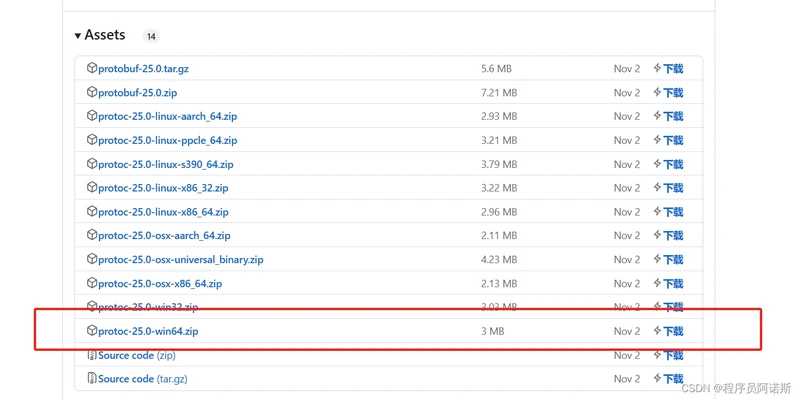
大家可以根据自己需求安装。安装之后配置下环境变量。
然后执行:
protoc --version
查看下版本号,如果没有输出版本号就是没安装成功或者环境变量没配好。
第一个trpc程序
创建项目目录
创建一下的目录结构,模拟项目操作
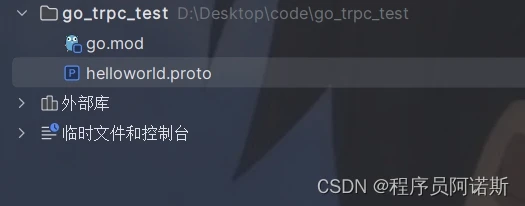
编写helloworld.proto文件
syntax = "proto3";
package helloworld;
option go_package = "github.com/some-repo/examples/helloworld";
// HelloRequest is hello request.
message HelloRequest {
string msg = 1;
}
// HelloResponse is hello response.
message HelloResponse {
string msg = 1;
}
// HelloWorldService handles hello request and echo message.
service HelloWorldService {
// Hello says hello.
rpc Hello(HelloRequest) returns(HelloResponse);
}
执行命令
trpc create -p helloworld.proto -o out
cd out
go run .
执行命令后会生成以下文件目录
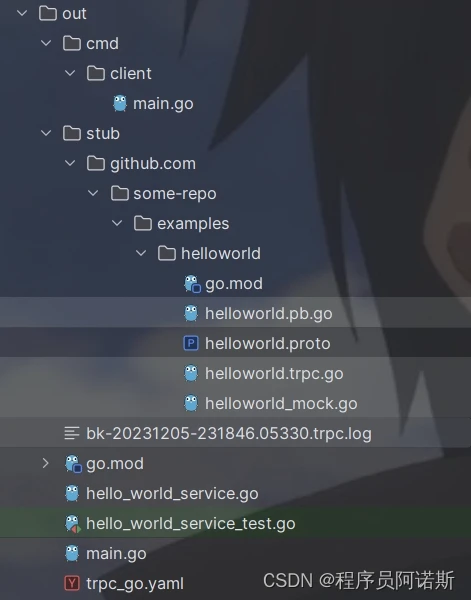
trpc_go.yaml是trpc的配置文件
global: # Global configuration.
namespace: Development # Environment type, either Production or Development.
env_name: test # Environment name for non-production environments.
server: # Server configuration.
app: yourAppName # Application name for the business.
server: HelloWorldService # Process server name.
bin_path: /usr/local/trpc/bin/ # Path to binary executable files and framework configuration files.
conf_path: /usr/local/trpc/conf/ # Path to business configuration files.
data_path: /usr/local/trpc/data/ # Path to business data files.
filter: # List of interceptors for all service handler functions.
- simpledebuglog
- recovery # Intercept panics from business processing goroutines created by the framework.
service: # Services provided by the business, can have multiple.
- name: helloworld.HelloWorldService # Route name for the service.
ip: 127.0.0.1 # Service listening IP address, can use placeholder ${ip}. Use either ip or nic, ip takes priority.
# nic: eth0
port: 9000 # Service listening port, can use placeholder ${port}.
network: tcp # Network listening type: tcp or udp.
protocol: trpc # Application layer protocol: trpc or http.
timeout: 1000 # Maximum processing time for requests in milliseconds.
client: # Backend configuration for client calls.
timeout: 1000 # Maximum processing time for all backends.
namespace: Development # Environment for all backends.
filter: # List of interceptors for all backend function calls.
- simpledebuglog
service: # Configuration for individual backends.
- name: helloworld.HelloWorldService # Service name for the backend.
namespace: Development # Environment for the backend.
network: tcp # Network type for the backend: tcp or udp (configuration takes priority).
protocol: trpc # Application layer protocol: trpc or http.
target: ip://127.0.0.1:8000 # Service address for requests.
timeout: 1000 # Maximum processing time for requests.
plugins: # Plugin configuration.
log: # Log configuration.
default: # Default log configuration, supports multiple outputs.
- writer: console # Console standard output (default).
level: debug # Log level for standard output.
- writer: file # Local file log.
level: info # Log level for local file rolling logs.
writer_config:
filename: ./trpc.log # Path to store local file rolling logs.
max_size: 10 # Maximum size of local file rolling logs in MB.
max_backups: 10 # Maximum number of log files.
max_age: 7 # Maximum number of days to keep logs.
compress: false # Whether to compress log files.
proto文件介绍
syntax
syntax用于制定protoc的版本,proto2或proto3,新版本proto3中必填。
message
message:protobuf中定义一个消息类型式是通过关键字 message字段指定的。消息就是需要传输的数据格式的定义message关键字 类似于C++中的class,JAVA中的class,go中的struct。
在消息中承载的数据分别对应于每一个字段,其中每个字段都有一个名字和一种类型个proto文件中可以定义多个消息类型。
字段规则
-
required:消息体中必填字段,不设置会导致编码异常。在protobuf2中使用,在protobuf3中被删去
-
optional:消息体中可选字段。protobuf3没有了required,optional等说明关键字,都默认为optional
-
repeate:消息体中可重复字段,重复的值的顺序会被保留在go中重复的会被定义为切片。
消息号
在消息体的定义中,每个字段都必须要有一个唯一的标识号,标识号是[1,2^29-1]范国内的一个整数
嵌套消息
可以在其他消息类型中定义、使用消息类型,在下面的例子中,person消息就定义在Personlnfo消息内如
message PersonInfo{
message Person{
string name = 1;
int32 height =2;
repeated int32 weight = 3;
}
repeated Person info = 1;
}
如果要在它的父消息类型的外部重用这个消息类型,需要Personlnfo.Person的形式使用它,如:
message PersonMessage{
PersonInfo.Person info = 1;
}
服务定义
如果想要将消息类型用在RPC系统中,可以在**.proto文件中定义一个RPC服务接口**,protocol buffer编译器将会根据所选择的不同语言生成服务接口代码及存根。
service $earchService{
# rpc 服务函数名 (参》返回(返回参)
rpc Search(SearchRequest) returns (SearchResponse)
}
服务端编写
out/main.go
package main
import (
"context"
"fmt"
pb "github.com/some-repo/examples/helloworld"
_ "trpc.group/trpc-go/trpc-filter/debuglog"
_ "trpc.group/trpc-go/trpc-filter/recovery"
trpc "trpc.group/trpc-go/trpc-go"
"trpc.group/trpc-go/trpc-go/log"
)
type service struct {
pb.UnimplementedHelloWorldService
}
func (s *service) Hello(ctx context.Context, req *pb.HelloRequest) (*pb.HelloResponse, error) {
fmt.Println("hello " + req.Msg)
return &pb.HelloResponse{Msg: "hello " + req.Msg}, nil
}
func main() {
s := trpc.NewServer()
pb.RegisterHelloWorldServiceService(s.Service("helloworld.HelloWorldService"), &service{})
if err := s.Serve(); err != nil {
log.Fatal(err)
}
}
客户端编写
out/cmd/client/main.go
// Package main is originally generated by trpc-cmdline v1.0.5.
// It is located at `project/cmd/client`.
// Run this file by executing `go run cmd/client/main.go` in the project directory.
package main
import (
"fmt"
pb "github.com/some-repo/examples/helloworld"
_ "trpc.group/trpc-go/trpc-filter/debuglog"
trpc "trpc.group/trpc-go/trpc-go"
"trpc.group/trpc-go/trpc-go/client"
"trpc.group/trpc-go/trpc-go/log"
)
func callHelloWorldServiceHello() {
proxy := pb.NewHelloWorldServiceClientProxy(
client.WithTarget("ip://127.0.0.1:9000"),
client.WithProtocol("trpc"),
)
ctx := trpc.BackgroundContext()
// Example usage of unary client.
reply, err := proxy.Hello(ctx, &pb.HelloRequest{Msg: "itcyy"})
fmt.Println(reply)
if err != nil {
log.Fatalf("err: %v", err)
}
log.Debugf("simple rpc receive: %+v", reply)
}
func main() {
// Load configuration following the logic in trpc.NewServer.
cfg, err := trpc.LoadConfig(trpc.ServerConfigPath)
if err != nil {
panic("load config fail: " + err.Error())
}
trpc.SetGlobalConfig(cfg)
if err := trpc.Setup(cfg); err != nil {
panic("setup plugin fail: " + err.Error())
}
callHelloWorldServiceHello()
}
运行结果
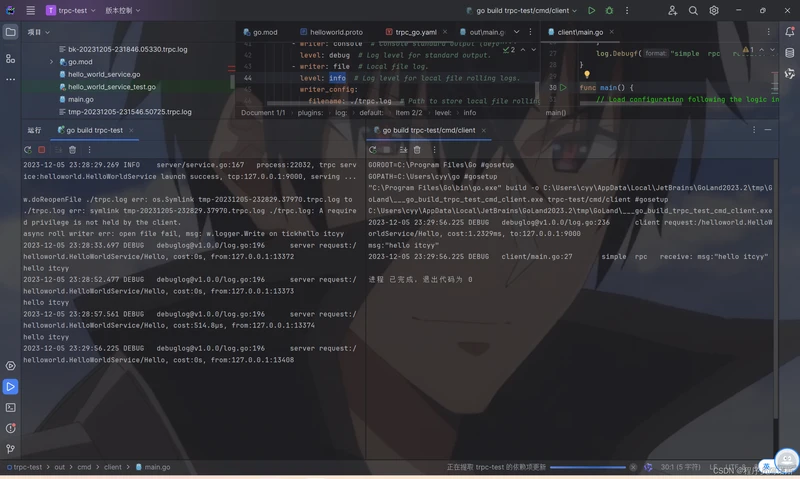
先运行out下的main.go,再运行out/cmd/client/main.go。
两边都打印出hello itcyy的结构即运行成功,如图所示
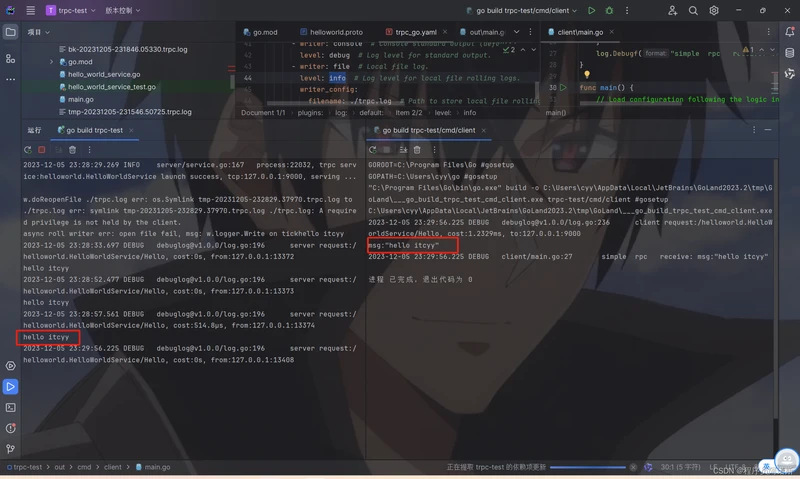
总结
关于trpc-go的快速入门就到此结束了,感兴趣的可以关注下博主,查看后续文章哦!
